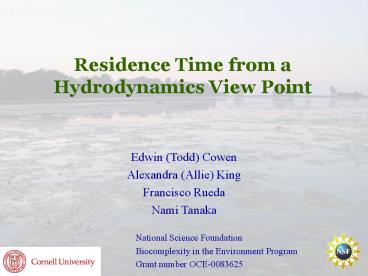Residence Time from a Hydrodynamics View Point - PowerPoint PPT Presentation
1 / 19
Title:
Residence Time from a Hydrodynamics View Point
Description:
Residence Time from a Hydrodynamics View Point. Edwin (Todd) Cowen. Alexandra (Allie) King ... Barotropic forcing from tributaries through embayments to LO ... – PowerPoint PPT presentation
Number of Views:41
Avg rating:3.0/5.0
Title: Residence Time from a Hydrodynamics View Point
1
Residence Time from a Hydrodynamics View Point
Edwin (Todd) Cowen Alexandra (Allie)
King Francisco Rueda Nami Tanaka
National Science Foundation Biocomplexity in the
Environment Program Grant number OCE-0083625
2
External Forcing Scenarios
- Barotropic forcing from tributaries through
embayments to LO - Barotropic forcing from LO to embayments
- Barotropic forcing from embayments to LO
- Baroclinic exchange flow between embayments and LO
3
Lake Ontario
Little Sodus Bay
4
Residence Time Distributions
Residence time distribution r(t) Q(t)C(t)/V0
May 2002
r(t) (days -1)
t (days since dye release)
Fall 2003
r(t) (days -1)
t (days since dye release)
5
Residence Time Distributions are NOT Complete
Only 65 of the dye leaves the pond during our
observations.
May 2002
r(t) (days -1)
t (days since dye release)
Only 61 of the dye leaves the pond during our
observations!
Fall 2003
r(t) (days -1)
t (days since dye release)
6
Standard Practice is to Extrapolate the RTD Using
an Exponential Tail
May 2002
7
Standard Practice is to Extrapolate the RTD Using
an Exponential Tail
May 2002
Even with the exponential tail, only 66 of the
dye leaves the pond just 1 more than if we
hadnt extrapolated at all!
8
How to Extrapolate the May 2002 RTD AND
Understand the Physics?
- 1D Dead-Zone Model
- Originally developed for river modeling in the
1970s. - Further developed for wetlands by Andradóttir and
Nepf (2000).
9
1D Dead-Zone Model
Divide Sterling Pond into two zones
10
1D Dead-Zone Model
- Divide Sterling Pond into two zones
- Advective Channel
- Length L
- Average cross-sectional area Ac
- Average velocity u and corresponding flow rate Q
uAc - Longitudinal dispersion Kx? uh
L
Kx? uh
Ac
QuAc
11
1D Dead-Zone Model
- Divide Sterling Pond into two zones
- Advective Channel
- Length L
- Average cross-sectional area Ac
- Average velocity u and corresponding flow rate Q
uAc - Longitudinal dispersion Kx? uh
- Stationary Dead Zone
- Average cross-sectional area Ad
- No through-flow (u0)
- Rate of volumetric exchange ?Q between dead zone
and channel assumed proportional to Q
Ad
?Q?Q
L
Kx? uh
Ac
QuAc
12
Results
Mean residence time of 0.88 days
best-fit dead-zone model
May 2002
100 of the dye leaves the pond with the
dead-zone model solution
exponential tail
13
Macrophytes Change Things Sort of
May, 2002
- Very strong inflow from Sterling Creek (22
m3/s). - Negligible forcing from Lake Ontario.
- Low macrophyte density (40 g/m2).
Fall 2003
- Low inflow from Sterling Creek (2 m3/s).
- Strong barotropic forcing from Lake Ontario
during Hurricane Isabel. - Weak upwelling of Lake Ontario followed the
hurricane. - Extremely dense macrophytes (190 g/m2)
14
Spatio-temporal changes in RT are significant!
15
More upwelling events lower flushing times
16
Upwelling Driven Exchange Appears to Correlate
with Secchi Disk Depth Reduction Nutrient Flux
Driven Biological Growth?
17
Summary range of residence times
18
Ongoing Work
- Transitioning to laboratory effort on the effects
of heterogeneity in macrophyte coverage on
momentum and mass transport - Collaborating with Bob Johnson
- Interested in upwelling/event driven work
- Hairston/Bain groups?
- Interested in comparing other approaches at
estimating residence/flushing times. - Driscoll/Bain?
- Were hoping to be funded on the first bullet and
if so can continue to think about the second.
19
Center on Cayuga Lake for Education, Athletics,
Research (CCLEAR?)
Ground breaking February 2007 Assistant Professor
Civil Environmental Engineering Director,
DeFrees Hydraulics Laboratory































